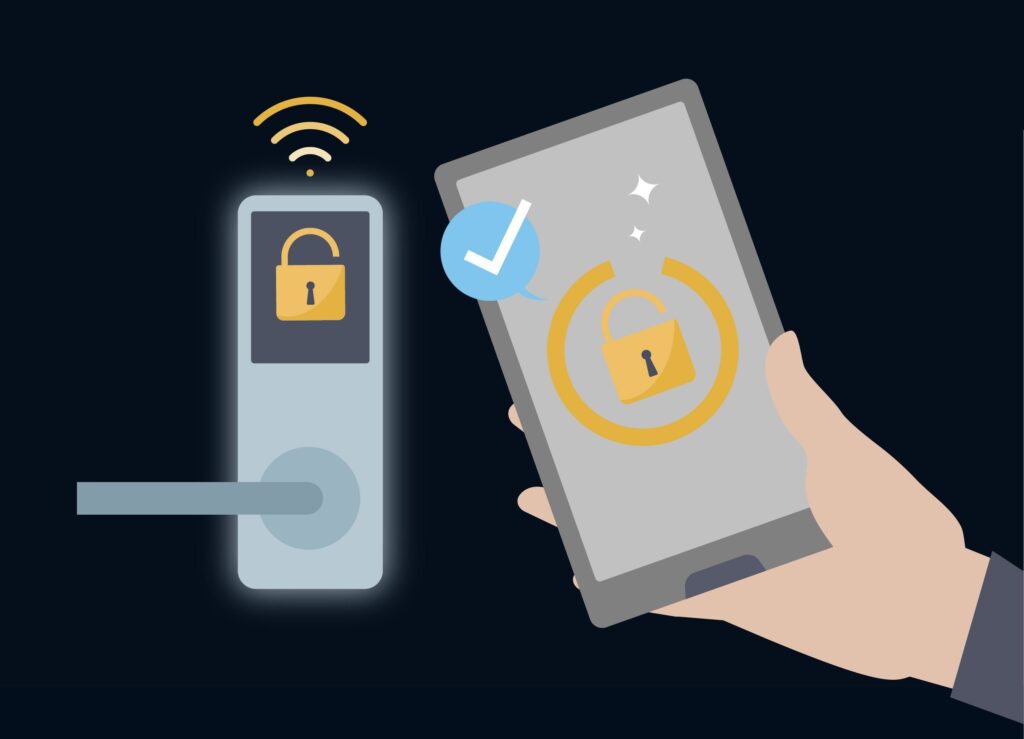Mobile solutions for access control present a big opportunity to deliver a wide range of user-friendly applications and drive market growth. The backbone of mobile access control is undoubtedly mobile credentials, which have increasingly been shaping the landscape of access control technologies, offering a blend of convenience, security, and remote manageability that is winning over the younger generations of building occupants.
Primarily using Bluetooth Low Energy (BLE) and Near-Field Communication (NFC) as communication protocols, mobile credentials are virtual keys stored on smartphones. First and foremost, they offer the advantage of leveraging essential personal devices that users are less likely to lose or forget, thus enhancing user convenience. Administrators also benefit from being able to remotely issue, revoke, or replace these credentials, thanks to their cloud-based architecture.
That software architecture relies on specialized applications acting as digital keys by interfacing with compatible card readers to control access to authorized entry points. The move to digital credentials effectively eliminates the need for physical cards, streamlining both user experience and administrative processes.
On the hardware side, conventional card readers are increasingly either being retrofitted or entirely replaced to support BLE and NFC signals for mobile credentials. To cater to the wide range of different user devices and preferences during this transitional phase, vendors generally adopt a hybrid approach, which supports both physical cards and mobile credentials.
According to our latest research, the mobile access control credentials market is set to jump from $295 million in revenues 2022 to a healthy $752 million by 2028, at a high projected CAGR of 16.9%. “Although we do not expect the market to exceed smart cards in terms of number of credentials issued annually, with a higher cost per credential, we expect the market for mobile credentials to surpass Smart Cards annual revenues by 2028,” the study says.
Mobile access control technology's adoption has been significantly influenced by the COVID-19 pandemic, which has driven the general demand for touchless access control solutions. Several vendors now offer add-ons for existing readers to integrate mobile credential capabilities, mitigating the need for complete system upgrades.

Mobile Access Control Technology & Adoption
However, despite all these advantages, mobile credentials are still a maturing technology, facing challenges such as varying support across mobile operating systems, dependency on the phone's battery life, and limitations in Bring-Your-Own-Device environments. Furthermore, solutions are typically deployed in addition to traditional access control technologies rather than serving as direct replacements.
Security concerns around mobile access control technology also persist. BLE provides a flexible read range, extending from a few inches to approximately 30 meters. However, this flexibility can sometimes be problematic with sporadic connectivity and potential unauthorized access issues. In contrast, NFC operates within a much more restricted read range, typically under 10 cm, thereby reducing the likelihood of unintended unlocks but also limiting its applications.
Most experts concur that NFC generally offers a more reliable and secure access control than BLE, although the latter offers greater flexibility for scenarios that do not demand the highest levels of security. In the future, experts suggest that Ultra-Wideband (UWB) could eventually replace both BLE and NFC, offering enhanced directional accuracy at a range of 250 feet. This currently appears a long way off, however, as UWB is still not supported by the vast majority of smartphones.
“Mobile access control is experiencing a significant uptick in adoption, although it's essential to note that the technology is still in its early stages,” reads our comprehensive market report. “The interplay of these technologies and market trends presents a multifaceted yet promising future for mobile access control, opening up numerous possibilities for innovation and refinement. The momentum is palpable, driven by several key indicators that point to a gradual but definitive shift in how access control is being managed and deployed.”
A 2022 survey by IFSEC Global found that more than four in ten businesses are planning to adopt a mobile-ready contactless access control solution (42%) while just under one in four have already upgraded to a mobile-ready system (24%). Additionally, it was reported that 20% of respondents chose contactless technology and 18% chose mobile access as the one technology they believed would have the greatest impact on improving physical access control.
“The landscape of mobile access control adoption is dynamic, with strong indicators of continued growth. However, hybrid implementations that combine mobile and physical credentials are likely to dominate in the near term,” reads our brand new report. “We project a steady increase in the rate of adoption over the next 5-10 years. And, while mobile access control credentials are poised to achieve mainstream use, they are unlikely to completely replace physical credentials in the foreseeable future.”



